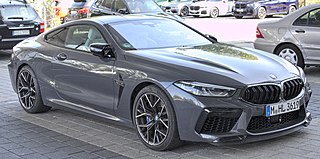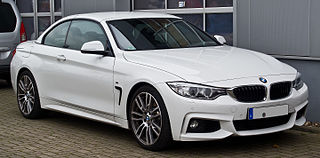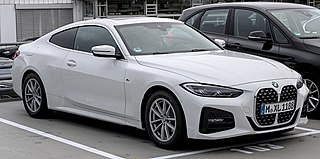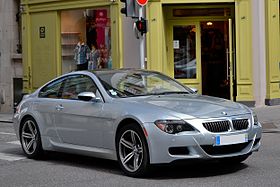
The BMW 6 Series is a range of grand tourers produced by BMW since 1976. It is the successor to the E9 Coupé and is currently in its fourth generation.

The BMW E24 is the first generation of BMW 6 Series range of grand tourer cars, which was produced from January 1976 to 1989 and replaced the BMW E9 coupé.

The second generation of the BMW 6 Series consists of the BMW E63 and BMW E64 grand tourers. The E63/E64 generation was produced by BMW from 2003 to 2010 and is often collectively referred to as the E63.

The BMW M3 is a high-performance version of the BMW 3 Series, developed by BMW's in-house motorsport division, BMW M GmbH. M3 models have been produced for every generation of 3 Series since the E30 M3 was introduced in 1986.

BMW M GmbH, formerly known as BMW Motorsport GmbH, is a subsidiary of BMW AG that manufactures performance cars.

The BMW M5 is a high-performance variant of the BMW 5 Series marketed under the BMW M sub-brand. It is considered an iconic vehicle in the sports sedan category. The M5 has always been produced in the sedan (saloon) body style, but in some countries the M5 has also been available as a wagon (estate) from 1992 to 1995, from 2006 to 2010, and since 2024.

The Aston Martin Vantage is a series of hand-built sports cars from the British automotive manufacturer Aston Martin. Aston Martin has previously used the "Vantage" name on high-performance variants of their existing GT models, notably on the Virage-based car of the 1990s. The modern car, in contrast, is the leanest and most agile car in Aston's lineup. As such, it is intended as a more focused model to reach out to potential buyers of cars such as the Porsche 911 as well as the exotic sports and GT cars with which Aston Martins traditionally compete.

Alpina Burkard Bovensiepen GmbH & Co. KG is an automobile manufacturing company based in Buchloe, in the Ostallgäu district of Bavaria, Germany that develops and sells high-performance versions of BMW cars. Alpina works closely with BMW and their processes are integrated into BMW's production lines, and is recognized by the German Ministry of Transport as an automobile manufacturer, in contrast to other performance specialists, which are aftermarket tuners. The Alpina B7 is produced at the same assembly line in Dingolfing, Germany, as BMW's own 7 Series. The B7's twin-turbo 4.4-litre V8 is assembled by hand at Alpina's facility in Buchloe, Germany, before being shipped to BMW for installation, and the assembled vehicle is then sent back to Alpina for finishing touches.

The BMW M4 is a version of the BMW 4 Series automobile developed by BMW's motorsport division, BMW M, that has been built since 2014. As part of the renumbering that splits the coupé and convertible variants of the 3 Series into the 4 Series, the M4 replaced those variants of the BMW M3. Upgrades over the standard BMW 4 Series include an upgraded engine, suspension, exhaust system, brakes and weight reduction measures including increased use of carbon fibre, such as on the roof of the car.

The BMW M8 is the high performance version of the BMW 8 Series (G15) marketed under the BMW M sub-brand.

The BMW Z4 (E89) is the second generation of the BMW Z4 range of two-door roadsters, and was produced from 2009 to 2016. The E89 replaced the E85/E86 Z4 and is the fourth model in the BMW Z Series.

The sixth generation of the BMW 5 Series consists of the BMW F10, F18, BMW F11 and BMW F07 executive cars and were produced by BMW from January 2010 to 2017, with F10 being launched on 20 March 2010 to domestic market and F11 in the summer of 2010. The F07 Gran Turismo was produced from early September 2009 to 2017, being launched in the domestic German market in late October 2009.

The third generation of the BMW 6 Series consists of the BMW F12, BMW F13BMW F06 executive-sized grand tourers. The F12/F13/F06 generation was produced from 2011 to 2018 and is often collectively referred to as the F12.

The BMW M2 is a version of the BMW 2 Series automobile developed by BMW's motorsport division, BMW M GmbH. As the 2 Series replaced the 1 Series coupé and convertible models, the first-generation M2 was marketed as the most basic M model in the range.

The first generation of the BMW 4 Series consists of the BMW F32, BMW F33 and BMW F36 compact executive cars. The F32/F33/F36 was produced from 2014 to 2020 and is often collectively referred to as the F32.

The first generation of the coupé and convertible range of the BMW 2 Series subcompact executive car consists of the BMW 2 Series (F22) for the coupé version and BMW 2 Series (F23) for the convertible version. The F22/F23 was in production from November 2013 through 2021 and is often collectively referred to as the F22.

The second-generation of the BMW 8 Series consists of the BMW G14, BMW G15 grand tourers and BMW G16 executive cars (E). The G14/G15/G16 generation has been in production since 2018, and is often collectively referred to as the G15.

The Alpina B6 (E63) is the second generation of the high performance grand tourer manufactured by German automobile manufacturer Alpina from 2005 to 2010. Based on the BMW 6 Series (E63), the car was available in coupé and convertible bodystyles. The B6 was introduced in 2005.

The Alpina B6 (F12) is the third generation of the high performance grand tourer manufactured by German automobile manufacturer Alpina. Introduced at the 2011 Tokyo Motor Show, the B6 was based on the BMW 6 Series and was available in coupé and convertible body styles, with the latter being introduced at the 2011 Frankfurt Motor Show. A third saloon bodystyle called the gran coupé was introduced in 2014. The Alpina B6 gran coupé was replaced by the Alpina B8 gran coupe (G16) in 2021.

The second generation of the BMW 4 Series consists of the BMW G22 along with the BMW G23 and BMW G26 compact executive cars. The G22 4 Series was launched in June 2020 and succeeds the F32 4 Series.































